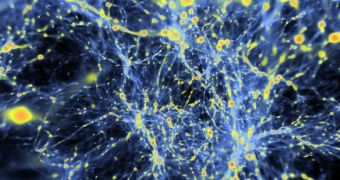One of the most potent sources of astronomical knowledge at this point are supercomputer simulations. Powerful processors take into account data that experts input, and then show all possible outcomes in a certain system. However, though significant progress has been made in this field, one large problem endured, and namely the fact that experts could not share their work on supercomputers with each other. All of that recently changed, as scientists in Portland and Chicago watched the same simulation in real-time, Space reports.
The team in Oregon managed to successfully trace the evolution of a simulation depicting how normal and dark matter interacted with each other during the early stages of the Universe. The work was carried out in Illinois, and both teams were involved in the same way video game players connect to the same game online. The data were streamed live between the two laboratories, experts involved in the experiment say. Theoretically, this could mean that the groups could have interacted in this environment with very little restrictions. Undoubtedly, future such attempts will focus on achieving this as well.
“This is an example of trying to break down that barrier – a barrier that gets higher every day as simulations get more complex,” explains Argonne National Laboratory (ANL) computer scientist Mark Hereld, who was a part of the Illinois group. He also reveals the groundbreaking implications the new achievement has. From now on, having the ability to stream supercomputer simulations online means that research groups around the world, that don't have access to massive processing power, could take part in joint research initiatives with colleagues from institutes, universities and organizations that were fortunate enough to have their work selected and alloted time on supercomputing facilities.
“We can measure the density of intergalactic gas by seeing how strongly it absorbs the light from distant objects, particularly quasars,” explains University of California in San Diego (UCSD) astrophysicist Rick Wagner. He was part of the team that ran the new simulation, aimed at discovering Baryon Acoustic Oscillations. These are clusters of elementary particles gathered in intergalactic gas, and the expert adds that they appear as “peaks” in the map depicting the Universe's density. “Measuring these peaks accurately is one of the best tools for nailing down the fundamental properties of the Universe,” he adds.
“Our data came from a supercomputer, but it could have come from a large scale astronomical survey, like Pan-STARRS or LSST – or a particle collider. The freedom to move our data allowed us to see it in ways we never thought possible; it will be great to see this capability made available to more researchers,” Wagner says. “If your science is the discovery science where you have to interact, hop around and look for stuff in a simulation, that's the time when you need to do the rendering in real-time,” Hereld concludes.

 14 DAY TRIAL //
14 DAY TRIAL //